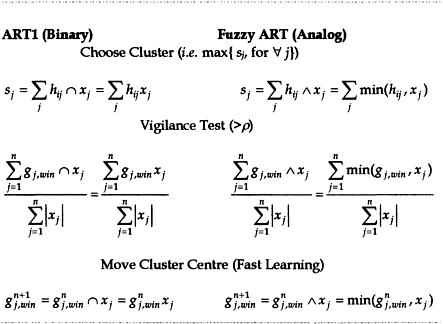44.
| [Cover] [Contents] [Index] |
Page 137
Fuzzy ART substitutes the concept of the fuzzy set (described in detail in Chapter 4) for the crisp set as used in ART1 system. Both Equations (3.47) and (3.51) can be regarded as the crisp set intersection operation by the intersection operator ( ). In fuzzy ART, the operator (
). In fuzzy ART, the operator ( ) is replaced by the fuzzy AND operator (
) is replaced by the fuzzy AND operator ( ), where p
), where p q=p·q for the logical AND operation, and p
q=p·q for the logical AND operation, and p q=min (p, q) for the fuzzy AND operation. A comparison between ART1 and fuzzy ART is given in Figure 3.17. The third step (i.e. moving the cluster centre) shown in Figure 3.17 needs some comment. According to Equation (3.52), the update of the cluster centre vector for fuzzy ART can be written as:
q=min (p, q) for the fuzzy AND operation. A comparison between ART1 and fuzzy ART is given in Figure 3.17. The third step (i.e. moving the cluster centre) shown in Figure 3.17 needs some comment. According to Equation (3.52), the update of the cluster centre vector for fuzzy ART can be written as:
 |
(3.53) |
where the operator ‘ ’ is replaced by ‘
’ is replaced by ‘ ’ in the case of fuzzy logic. Fast learning corresponds to the value of the learning rate parameter β being set equal to 1.
’ in the case of fuzzy logic. Fast learning corresponds to the value of the learning rate parameter β being set equal to 1.
The simplified architecture of a fuzzy ARTMAP is shown in Figure 3.18. Figure 3.18a illustrates a fuzzy ARTMAP network formed by two fuzzy ART systems, ARTa and ARTb, which are linked by an inter-ART module called the map field, denoted by Fab. ARTa is used to input the values of the data features (e.g. pixel values), while ARTb is used to receive the

Figure 3.17 Comparison between ARTI and fuzzy ART (modified from Carpenter et al., 1992).
| [Cover] [Contents] [Index] |
EAN: 2147483647
Pages: 354